Abstract: This is a chronicle of practical work and experimentation probing my previously published discussion, which considered the likely ecology and reasons for the extinction of the Mazarine Blue in the British Isles (White, 2016). Together with help, I try to resolve the matter and establish the first viable population of the species in Britain for over a hundred years. It is my desire that duly informed persons visit the colony and see the butterfly for themselves. The more that do so, thereby showing an active concern, the greater the likelihood the Mazarine Blue, together with various indicative fauna and flora, will continue to be given proper habitat care and perhaps encouragement at other sites. The location chosen is certainly large enough to accommodate all who may show an interest and, even at this stage, the initial findings suggest a butterfly capable of increasing in number in line with its new surroundings.
Martin White passed away on October 12th 2020 before he was able to complete his studies on the Mazarine Blue. This article is a previously unpublished work, originally written at the end of 2017, that was to form the basis of a series of articles. It is published here with Martin's permission.
The site of this re-establishment is an old Derbyshire colliery spoil-heap totalling 84 hectares which has been capped with low quality soil, extensively planted with woodland and re-seeded to form large areas of interconnected grassland of wildflower meadows surrounded by trees. This was formerly Langwith Pit-tip and has now been renamed Poulter Country Park. A major part of the grassland habitat is thought by this researcher to be a very close approximation to pre-industrial 'MG5+' meadow, albeit this dynamic was won solely by chance. The landscape is obviously artificial although, by comparing it to similar meadows of SSSI status, it has a very rich flora and a far larger assemblage of ants. Both these factors are deemed necessary for the former ecology of the extinct British Mazarine Blue (White, 2016).
The meadowland component of the site currently boasts 85 different flora of grassland axiophytic status, these being the officially designated vascular plants associated with native, species-rich, grassy areas. By contrast, the richest North Midlands neutral meadowland SSSI, at South Field, Laxton Sykes, Nottinghamshire, has only 50 grassland axiophytes (from personally collected information). Conversely, also in Nottinghamshire, any site can claim SINC status, 'a Site of Importance for Nature Conservation', with a mere 14 neutral grassland axiophytes (NBGRC, 2007). It is here strongly argued that species-interdependent diversity on all pH 5.2 to 6.2 grasslands was widely destroyed or was steadily degraded throughout the whole of Britain following our singular and widespread enclosure of farmland. This was officially sanctioned through our Enclosure Acts of the 18th and early 19th centuries and resulted in our very own large-scale extinction event, universally affecting a then-not-uncommon and wide-ranging butterfly-rich habitat. This drew to an unremitting close the demise of the Mazarine Blue in Britain by the early 20th century. A similar loss is now being repeated on the continent to a less provincial timescale (Cizek et al., 2012). The species would almost certainly have been resident within our lands and in those of mainland Europe following the last ice age, just over ten thousand years ago.
In its relatively short 15-year history, Poulter has acquired the richest breeding butterfly fauna of any location in Derbyshire. Moreover, after studying data sets compiled from a variety of sources, the majority of its unusual resident butterflies and much else besides occur at comparatively higher densities than those found in most other Derbyshire sites (from personally collected information). Its huge ant population and size, coupled with its unique and inspiring flora, gives Poulter the potential to become the best grassland butterfly site in Britain. However, it already comfortably leads the field in British butterflies found on MG5 neutral grasslands, SSSI or otherwise, which typically have as their very best components such minor specialities as Common Blue (Polyommatus icarus), Small Copper (Lycaena phlaeas) or even possibly Small Heath (Coenonympha pamphilus) (NVC, 2013). Though impressive as all this may sound, such a wealth of wildlife can only be maintained or indeed enhanced should at least a moderate understanding of good management prevail and deliver the intended results - a facet sadly lacking over much of our beleaguered countryside and elsewhere.
As practices stand and with ant populations low or absent on neutral grasslands, Poulter may therefore be the only current British site capable of offering a permanent safe haven for the Mazarine Blue. The discovery or creation of clover-rich sites, maintaining such species as Dingy Skipper (Erynnis tages), Dark Green Fritillary (Argynnis aglaja), Marbled White (Melanargia galathea) or Small Heath would certainly suggest an ant ecology and management policy sufficient to provide for more potential colonies of this charming blue.
The personal cost involved to put this species back into the British landscape, where it undoubtedly belongs, came to less than £10 and was carbon neutral.
On 28th July 2016, one male and three female Mazarine Blues were caught in the Mercantour National Park in south-east France. This, the donor site, is situated on the route de la Bonette (D64) which crosses the Col de la Bonette and is said to be the highest mountain pass in Europe. The butterflies were taken east of the pass at an altitude of approximately 2450 metres (Fig. 1).
 |
| Figure 1. Site of the donor stock, along the Route de le Bonette, France |
On arrival at Worksop the following day, the butterflies were placed into two cages containing growing plants of Kidney Vetch (Anthyllis vulneraria). After a couple of days, as no eggs had been noted, Red Clover (Trifolium pratense) was suggested, and the first ova were soon deposited after flowering stems of the clover were introduced into the cages. Subsequently, most of the eggs were laid on Red Clover florets and a few close to the florets on the cage wires. Only two eggs were seen to be laid on the florets of Kidney Vetch despite the butterflies using this plant as a nectar source. Neither of the larvae that may have hatched from these two ova could later be found.
The first larva was found hatched on 8th August. Typically, the larvae eat a ragged hole in the top or side of the egg shell in order to emerge though, on a few occasions, they made their exit through the bottom of the ova and underlying petals directly into the florets. After two weeks in captivity, having laid no fewer than 680 ova, the three females were released on Meadow 5, Poulter Country Park, Derbyshire (SK52647118) (Figs. 2 & 3). This was around midday on the 12th of August and, over thirty minutes, approximately eight eggs were seen to be laid on Red Clover florets, three of which were confirmed using a hand lens.
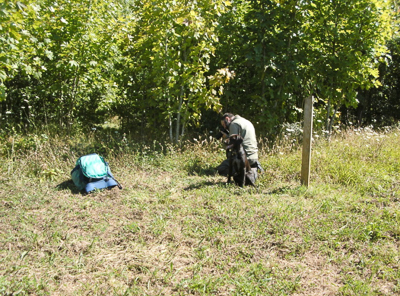 |
| Figure 2. The initial release site: Meadow 5, Poulter Country Park, Derbyshire, with Heidi performing guard duty, while Richard Priestley photographs the butterfly in Figure 3 |
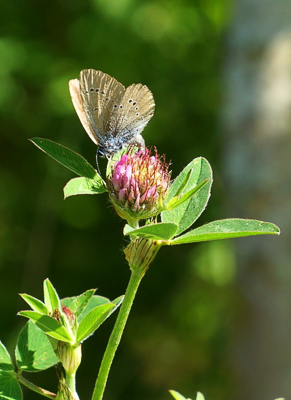 |
| Figure 3. One of the released females laying an egg |
The first larva to change its skin into a second instar was found on 15th August.
Under feeding stress on Red Clover, the first instar larvae have proven to be cannibalistic. Typically, the early larvae are to be found inside the youngest clover florets, feeding on the generative parts of the flower, including the pollen, though later are only to be found grazing on, and sometimes completely hidden within, the developing ovaries. Two second instar larvae were accidently killed while trying to dissect them from ovaries using a 20x microscope. The larvae transfer themselves from one floret to another if the ovaries remain undeveloped due to a lack of fertilisation. It is only when more than one individual encounters such insubstantial ovaries within a floret that cannibalism has been observed. Three equally sized caterpillars were deliberately kept confined in one Red Clover floret with sufficient food for several days without any noticeable ill effect. Cannibalism within the first instar has therefore to be concluded as unusual in the wild, except where overcrowding occurs.
An unidentified species of leaf beetle larva was found predating a Mazarine Blue caterpillar on 18th August. Another larva also had a bite mark, probably inflicted by a leaf beetle, though it was apparently still quite healthy and continued to feed. After its next instar change it had completely recovered and, later still, successfully entered diapause. Flower bugs Anthocoris nemorum and Orius insidious were also present in the clover heads and are as yet unconfirmed predators of the larvae of this particular butterfly. A typical sleeved tub used for rearing is shown in Fig. 4.
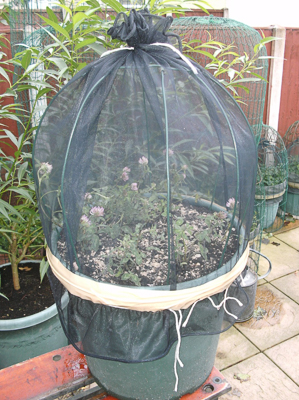 |
| Figure 4. A typical rearing cage, Worksop |
40 individuals, mostly larvae and a few ova, were relocated onto a fresh, caged tub of Red Clover using the micro-sleeve method. The sleeves were removed after about four days and the old florets were discovered attached to the new flower heads by silk. Seemingly, the larvae successfully transferred themselves.
All plant material used for laying was thoroughly searched for ova on the 21st August and only empty egg shells, defective ova or damaged ova were found. All hatching was therefore presumed to have concluded by this date. All three females were certainly laying fertile eggs.
A first example of a third instar larva was noted on 23rd August, measuring 3 mm in length.
It is presumed the larvae cannot complete their pre-diapause life cycle within a single Red Clover flower head and that a second, younger head, further down the flowering stem from the head upon which the eggs were laid, is required for the larvae to successfully transfer and finish their development. The original laying heads reached a point where all had desiccated, with their ovaries mostly going to seed, and were therefore rejected by the larvae. Only those caterpillars that had transferred naturally to younger heads or had been artificially moved to such positions in the days up to the 24th or in the immediate period thereafter would survive. The remaining larvae had already begun to starve to death or eat each other. The problem was exacerbated by weevils (Sitopilus sp.) within the upper flower stalks and killing the flower heads, and a lack of fresh flower heads. This probably wouldn't represent itself under normal synchronised circumstances when the clover and larvae would be in phase. Indeed, most wild clover was way past its best and the stock was well behind, originating from one of the least advanced and highest altitudes in Europe. Unfortunately, with neither sufficient potted flowering Red Clover nor the time needed to successfully transfer all of the stock, approximately 300 larvae would inevitably be lost.
So, on the 25th of August, more through necessity than design, a hundred breeding-stock larvae (1st instar = 1; 2nd instar = 59; 3rd instar = 40) were dissected from old flower heads in the morning, ready for repositioning on a rainy afternoon on Meadows 4, 5 and 6. This was only made possible because the meadows had been mown between the 15th and 18th July during 2016 that, a month later, had resulted in a very good showing of Red Clovers flowers.
The practice at Poulter in the decade prior to 2016 was to hay the majority of its meadowland in early September. The cutting regime in mid-July 2016 proved unfortunate for many butterflies and day-flying moths, which failed to impress in 2017 against their previous high numbers. Luckily, on 17th May 2017, an agreement was reached between the Park Manager and the Cutting Contractor not to disturb Meadows 4, 5 and 6, and sixteen other nearby meadows (or units) in future years until the end of August or early September. This is to accommodate a Priority Action Plan Species, the Dingy skipper, a species whose larvae require virtually the whole summer to fully develop before they hibernate near ground level below most mowing operations. It was from captive stock introduced in 1994 onto a calcareous, non-landscaped portion of the old tip (Meadow 1) that the species first appeared. By 2003 it had colonised the main body of Poulter's meadows. These grassland areas are perhaps a singular example of this species occurring at such a middle pH site in the whole country, though the insect does occasionally breed on neutral fen or rush pasture and meadowland, utilising as its larval food source Greater Birds-foot-trefoil (Lotus pedunculatus), and flying later in the year.
The reinstated late-haying specifically aimed for the benefit of the skipper will undoubtedly assist Mazarine Blue and countless other grassland invertebrates. Indeed, late-haying did an excellent job beforehand, although a new meadow management plan is also due to be drawn up in 2019 and may yet have an unwelcome impact. Most management is, however, aimed at pleasing members of the public as long as the majority view of dog walkers remains unchallenged. Moreover, an increased number of entomological visitors may help boost a balanced perspective, while optimistically not damaging the prospects of the more unusual species many will no doubt come to seek.
Two larvae were found eating leaves of low auxiliary shoots on 26th August - one second and one third instar. Of the breeding stock originating from c.680 ova, about 300 were lost, 100 released, 40 transferred, and 18 accidently killed, leaving a total of 222. Three Black ant Lasius niger (sensu stricto) workers showed no interest when confined in a plastic box with a third instar Mazarine Blue larva, the caterpillars at this stage not yet having developed the organs necessary to attract ants.
Approximately 32 days after being laid, on the 1st of September, the first larva, a late-third instar, was discovered entering diapause in a small dead clover leaf at the base of a plant. Its length was 4.5 mm, the same as that recorded by noted expert Boris Stradomsky (Stradomsky, 2012).
A third instar larva was placed on the trail of Black ant workers from the same nest as the three individuals mentioned above. The ants only paused for the briefest of moments after encountering the larva.
Three days after the first larva was found entering diapause, it had moved position into the inside of a dead stipule, which it resembles. At the base of the same clover another had similarly positioned itself next to a stipule (Fig 5). It is now reasonable to suppose that while the mid-second to pre-diapause third instar caterpillars closely resemble the fading striped calyx of Red Clover, on which most either sit to feed or rest, the hibernating larvae become paler, possibly due to an emptying of the gut, and more cryptic within the drying stem stipule.
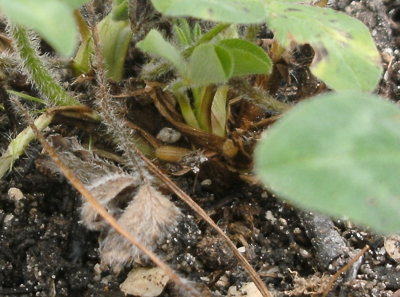 |
| Figure 5. Larvae in diapause, next to and within dead leaf stipules of Red Clover |
Conversely, during 2017, half the breeding stock of caterpillars were given shaded conditions throughout the third instar and these did maintain the red striped calyx pattern and began to enter diapause in the clover heads. These were later deliberately repositioned into the leaf litter, where the earlier cryptic colouring would be retained, making them comparatively easier to find against a paler background of dead moss, stipules and leaves (White, 2018). By 4th September 2016, around 10% of the larvae had entered diapause or had finished feeding. The final frass pellet of the larvae before diapause is pale pink instead of the usual orange. Typical hibernating quarters are shown in Fig 6.
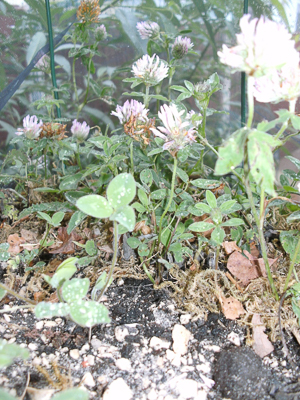 |
| Figure 6. Inside a typical hibernating cage showing leaf litter of dried moss and dead oak leaves |
Several other interesting facts have emerged. Virtually all freshly moulted second instar larvae ate their old shed skins, while none of the following third instar did. The larvae appear unusual among British butterflies in generally not heading upwards or towards the light when in search of food. This makes finding missing caterpillars in 'stemming material' difficult, though easy just prior to diapause, when on flower heads, as they invariably position themselves low down or inside the flower stipules and especially underneath cut flowers while in plastic boxes. Common carder bumblebees (Bombus pascuorum) were used to pollinate the flowers while the larvae were present with no problems, unless the larvae were newly positioned on such flower heads and readily dislodged. One larva died as a result of being bitten or nibbled by a larva of Light Brown Apple Moth (Epiphyas postviittana) though, conversely, a few previous deaths of the same species of moth can be attributed to hungry Mazarine Blue larvae and the accidental starvation conditions in which they were kept. Whether the species will eat or bite weevil larvae is yet to be ascertained, though under stress they will certainly consume tissue paper as well as take chunks out of each other. Notably, in the generation that followed, a pre-hibernation larva was discovered devouring a maggot (Diptera sp.), slightly larger than itself, reminiscent of eating a huge serving of blancmange (White, 2018). Five, fully diapause-sized larvae were found feeding side by side on the outside of one young, small flower head with apparently no lack of approbation.
By 5th September, all caterpillars were found feeding on leaves, stems or the green, newly developing, low auxiliary heads that had been transferred to proper flower heads. About 10 were found dead in such positions, presumably drowned in a combination of dew or rain water trapped in the axils and sap emitted by the plant, while the survivors were small in comparison and much greener in colour than their counterparts, though apparently all were still quite healthy, one having survived for at least 10 days eating non-flowering vegetative matter. By the following day, all were showing typical colouration after resuming a diet of flower parts.
A weevil larva placed along the trail of my Black ants (sensu stricto) was quickly found and taken back to the nest by a worker. Of the troublesome moth larvae, three were similarly positioned and provoked a lengthy response from one ant trying, but failing, to bite both ends of a larva and then going into an elaborate dance, shunting back and forth for about 15 seconds, apparently trying to rid itself of something unsavoury. This may be a case of biochemical defence.
Towards the end of the first week in September, the death toll of principally small, ill-fed caterpillars had ceased. Only one larva was recognisably small, apparently an early- to mid-third instar, though it still appeared healthy, as were all those that had been transferred onto flower heads from non-flowering foodstuffs. Of the surviving 106 individuals, half had attained diapause by 8th September and the vast majority of those still feeding on this date reached this condition a week later. No predation was noted on Mazarine Blue when a flower bug (Orius insidious) was accidently confined together with a larva on a cut clover flower head.
On 14th September a Red ant (Myrmica scabrinodis) worker presented to a Mazarine Blue larva showed no interest.
By 17th September, only four of the 106 surviving caterpillars were not yet hibernating. With a mean laying date of 6th August and a mean date for entering diapause of 9th September, this gives an average of 34 days between an egg being laid and the resulting caterpillar leaving the flower heads for the leaf litter in which to spend the winter. This critical figure dropped to 31 days, between June and July of 2017, after the stock, both wild and captive, became zoographically synchronised with the East Midlands (White, 2018). Hence, to have any chance of survival in the modern British meadowland landscape, the butterfly's habitat shouldn't be hayed till at least a month has passed since egg laying, otherwise all the clover heads, together with their dependent caterpillars or plausibly eggs, would be lost (Thomas and Lewington, 1991). Once in their principal hibernating positions, in the leaf litter or at the base of the clover, the larvae are below typical cutting height and therefore presumed reasonably safe. Perhaps notably, during early November 2016, the whole introduction site was machine-cut over the heads of the hibernating caterpillars, without any noticeable ill effect. Conversely, a few larvae may possibly hibernate in the flower heads in shadier locations, for example around field margins, and these would always be at risk whatever the timing of the cut (White, 2018).
The site most chosen for hibernating larvae (c.50%) is within dead, dry, pale orange-coloured moss, which they strongly match in appearance, the markings down the back blending nicely in with the irregular contours of the moss, making the caterpillars incredibly difficult to find. The larvae in the lower, dead leaf stipules (c.10%), originally thought to be the principal hibernating position, are a yellower pale straw colour, with less pronounced markings. The remainder of hibernators (c.40%) are in dead clover and oak leaves that are also pale straw in colour.
During late September, a few of the larvae were restless, moving about from one location to another, as indeed seemed to be the case with the earliest to enter hibernation. The more permanently fixed larvae appeared to throw a few loose strands of silk over their backs, but failed to make a pad on which to sit. Also by this date, some took on a slightly glossy appearance. One very small slug was removed from one of the four tubs. Slugs were obviously going to be a major problem.
Of the 106 caterpillars, all but two small individuals successfully entered diapause by early October. One died and the other refused to enter hibernation and remained in a flower head, and likely died some time later. Both were most probably formerly starved or were occasioned to eat non-flowering parts of the clover. The last two of the 104 healthy hibernators may have begun to enter diapause in flower heads, but were disturbed and later removed themselves to the leaf litter with the remainder. The clover leaves were cut back during the second week of October to allow more ventilation into the leaf litter.
The first caterpillar was found wandering post-hibernation on 20th February (Fig. 7).
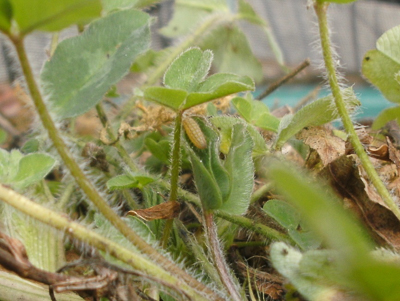 |
| Figure 7. An early post-hibernation caterpillar |
In early March, one larva was accidentally blown from a temporary container and lost.
By the final week in March, approximately 35% of the larvae were moving about, apparently out of hibernation. Twenty caterpillars were found during a fairly thorough search of a third of the leaf litter contained in the four overwintering tubs. Six individuals from one stripped tub - with 10 small dead clover plants within a bed of growing moss and with 7 slugs removed during the winter - were all accounted for. They all looked exceedingly healthy, hibernating in dried clover leaves and stipules. Of the other tubs, three larvae were found showing green colouration, as opposed to the typical wintering straw colour, indicating that they may have fed. That being said, no spring larvae had been observed feeding by 23rd March. Two dead caterpillars were discovered inside a curled oak leaf with 3 healthy individuals. From their positions and apparent decay, it is reasonable to suppose the two deaths occurred during the winter and not from stress due to premature emergence from hibernation, but probably from microscopic injury due to some earlier misadventure with flower bugs.
A second tub with two pre-winter individuals contained no apparent larvae after being stripped and thoroughly searched. With the five known losses since the 11th October tally of 104, this makes a possible maximum of 99 caterpillars, although the exact number of overwintered survivors will only be known when all the remaining tubs are stripped, and the livestock counted into fresh accommodation.
The first post-winter larval feeding was noted on the last day of March. The larvae bury their heads deep into the developing clover shoots and extrude frass vertically. Feeding signs are apparent by neat holes cut into the sides of young shoots. These develop into leaves with symmetrical feeding patterns (Fig. 8). An earlier caterpillar found wandering, with a greenish tint, was given a tub of fresh clover to itself - it closely studied the base of one particular plant for half an hour and then decided to resume a hibernating position inside a small curled dead leaf - the only such dried leaf it could find. It was therefore given bigger dried leaves and dead moss so that it might chose somewhere more suitable. This it did, suggesting the vast majority of larvae were still hidden deep in the leaf litter and would only resume feeding after a month spent wandering and re-settling.
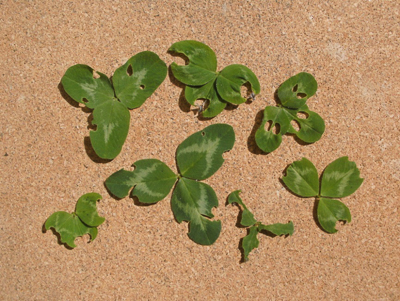 |
| Figure 8. Symmetrical feeding patterns on leaves of Red Clover |
The first fourth instar larva was confirmed on the 3rd of April. Length 5.5 mm.
The caterpillar placed in isolation on 31st March repositioning itself within a dead leaf, apparently doing this so it could more readily accomplish ecdysis, as it changed into a fourth instar on 4th April. This instar, like the third, fails to eat its shed skin. The fourth instar also shows for the first time the tentacle organs and dorsal nectary organ or honey gland, situated at the rear end. It is assumed likely the first three larval instars, including those in hibernation, are not directly in need of protection from ants, although the whole ant ecology is still thought very important throughout. Prior to winter, most development takes place out of sight, tight within the clover florets. During hibernation, when the larvae are mostly to be found concealed deep in the leaf litter, ant activity is absent or minimal. It makes sense that the species should have evolved ant attraction strategies only when necessary, and that these should manifest themselves soon after leaving hibernation when feeding resumes, when larvae are exposed for the first time on non-flowering vegetative matter. This also lends weight to the theory that the species is far better adapted to feed on Red Clover with its longer flowering season than all other MG5 Fabaceae. 'MG5' relates to the National Vegetation Classification and is the characteristic British habitat for Mazarine Blue, though it was only awarded such a notation after the industrial revolution had taken a widespread toll on its collective floral diversity (White, 2016).
On 15th April, a fourth instar larva was repeatedly positioned in close proximity to different species of ant at Niblum Quarry, South Yorkshire (SK540816), to see what reaction might be provoked. Black ant (Lasius niger sens. lat.) workers quickly showed an interest along its flanks, possibly close to the spiracles, and then assumed positions of greater expectation near the two tentacle organs. At one point, three worker ants were engaged in trying to stimulate these tentacle organs, which were frequently extended in unison. Note: Black ant workers showed little or no interest when presented with third instar larvae on 26th August and 1st September. The only interest from workers of Red ant Myrmica scabrinodis was in trying to bite the larva and several ran speedily round it, jaws open, occasionally attempting but failing to bypass the white hairs along the larva's sides, which just previously the Black ants had found no difficulty in negotiating. Yellow meadow ant (Lasius flavus), not an acknowledged MG5 species, showed the least interest. All but one worker from two attempted nests totally ignored the larva which, like the red ants, tried to bite through the hairs. Currently, this suggests greater emphasis should be placed on Mazarine Blue having evolved a more direct beneficial ecological relationship with Lasius niger than Myrmica scabrinodis, although both species may yet prove to be pivotal in the butterfly's natural history. Obviously, these experiments will be repeated with further ant species, when hopefully more stock is available and the risk of caterpillar loss less important.
My previous theory that the larvae might easily be dislodged from foliage to a safer environment at ground level, when approached by either the scythe of man or grazing animals, now looks decidedly faulty (White, 2016). Having bounced caterpillars around in a rucksack for half a day they were quite happy to sit tight, continue feeding or even resume feeding while all this activity was going on.
The first fifth instar larva was noted on 17th April, length = 8mm. The position of the tentacle organs is now more conspicuous. The remaining larvae were approximately 40% third and 60% fourth instar.
Two days later, a fifth instar larva was presented to my Black ant (sensu stricto) workers. Within a few seconds, two became interested. This was similar to 15th April only this time, after drumming the rear flanks, one ant spent most of its time at the honey gland. The two ants appeared to communicate with each other via their antennae and the abdomens of both vibrated conspicuously while attending the larva. This time the two tentacle organs didn't necessarily extend in unison, but in a somewhat disparate manner. One ant was still present with the larva an hour later.
A Red Clover feeding, mid-fifth instar caterpillar was confined for the late afternoon of 22nd April, and the following night, on flowering shoots of Common Vetch (Vicia sativa) to see if it would utilise this as a foodstuff. It refused to eat but was happy to resume when placed back onto clover shoots.
The next day, the same individual was taken to Bedford Purlieus SSSI NNR, Northamptonshire, to see what reaction might be obtained from various ant species. Wood ant (Formica rufa) (at TF041004) responded in a similar way as Lasius niger had on the 15th, with up to three ants stimulating the tentacle organs and then one feeding from the honey gland. A fourth instar Black Hairstreak (Satyrium pruni) larva, placed with the same Wood ants, provoked no response. Red ant Myrmica ruginodis (at TF042004) showed very little interest in the Mazarine Blue larva and one Myrmica scabrinodis worker (at TF041003), as before, tried to bite the caterpillar through the hairs along its flanks.
A fifth instar larva placed near Red ant Myrmica sabuleti workers on 29th at Poulter Country Park, Meadow 1 (SK525715), gave occasional interest to the ants for about five minutes until one stimulated the tentacle organs and began feeding from the honey gland for a few seconds. The same individual was then taken to Thoresby Border, Nottinghamshire (SK629730), and similarly subjected to workers of Formica lemani. Provoking any response was difficult as these ants seemed more interested in running away and hiding from view. One or two gave a cursory pause and this indeed stimulated the larva to erect its tentacle organs on a single occasion. This caterpillar was again transported to a further site, this time with closely related Formica fusca, at Clumber Road End Wood, Nottinghamshire (SK596761). The reaction was the same as for lemani, though with no response from the larva.
Three species of ant, niger, sabuleti and rufa, which are known to attend and feed from Common Blue, are now presumed exactly the same as those for larvae of Mazarine Blue, and each of the Mazarine Blue's three taxonomically eclectic attendant ant species appears to be one half of the major ant partnerships found, occupying the three principal habitats for the butterfly, namely damp neutral grassland (MG5), calcareous grassland, and open wood pasture, respectively. The Common Blue also attracts Lasius flavus and L. alienus, although the Common Blue can occur in abundance in the absence of ants and in more ruderal habitats (Fiedler, 1991). With all three ant species covering ground in close proximity to one another, and presumably with their typical respective partners, scabrinodis, flavus and nitidulus, this would in theory give Mazarine Blue its greatest ecological advantage. It now has to be considered noteworthy that Glanvilles Wootton in Dorset, with its historically famous Mazarine Blue colony, also had old records for Wood ant (Barrett, 1968).
At the very end of April, a fifth instar larva was confined overnight on the flowering shoots of Bush Vetch (Vicia sepium). It fed conspicuously on the lower parts of a flower.
Early May, one caterpillar was discovered to have bite marks and discoloured prolegs in a tub of otherwise completely healthy individuals. It is possible that this was one of the larvae subjected to wild Myrmica scabrinodis workers.
All overwintering tubs were finally stripped of livestock. The final headcount stood at 62 larvae from the 104 total of 11th October. One was accidently lost and the remaining 41 vanished sometime during the winter. These were presumed predated due to slugs or flower bugs or expired from ill health due to an earlier inappropriate diet and shrivelled away, undetectable.
On 6th May, three feeding, late-fifth instar caterpillars were individually confined on flowers of Broad Bean (Vicia faba), a modern MG5 casual, Common Birds-foot-trefoil (Lotus corniculatus) and Red Clover with embryonic flowers. Overnight, all three fed voraciously, producing between them 20 to 30 frass pellets apiece. The larva on Red Clover consumed what little flowering material existed and then presumably moved to eat the vegetative parts. Interestingly, their respective frass pellets were differently coloured; black on Broad Bean, orange on Common Bird's-foot-trefoil and olive-green on Red Clover.
By the 10th, several larvae appeared to be fully grown at 12.5mm. Boris Stradomsky gives 13-15mm. (Stradomsky, 2012).
Three caterpillars were confined overnight on various flowering MG5 Fabaceae - Black Medick (Medicago lupulina), Common Vetch and Red Clover. The Red Clover larva fed well on the flowers, producing 20+ frass pellets, with the other two ignoring the flowers and only nibbling on leaves and producing very little frass.
The first pupation was noted in the leaf litter on 13th May. Length = 9.5mm. Boris Stradomsky rather neatly gives 9-10 mm (Stradomsky, 2012).
At the beginning of the third week in May, a final 15 fully grown caterpillars, not yet fixed for pupation, were transferred onto growing clover flower heads. Only 10 began feeding. The rest moved position into the leaf litter. In the other cages, approximately 12 had so far pupated and vary in size from 9 to 10.5 mm. Perhaps 40% fix themselves to a silken pad with a loose girdle of silk, with the rest happy enough without such attachment, most notably found under moss in the warmest parts of the tubs. One southerly tilted tub had a cluster of pre-pupae and pupae situated under the hottest part of the rim at the tub's highest elevation (Fig. 9). In future it will be highly advisable to maintain tub orientation for this particular insect at this particular time so as not to discourage larvae in the process of fixing for pupation. The spring larvae seem to desire warmth. It is notable they develop faster in tilted tubs in warm locations that have the upper foliage frequently cut back to allow better ingress of sunlight and heat. One tub kept with cooler conditions appears to have only half its caterpillars (5 missing). One individual looking for a pupation site in this particular tub had to be continually dissuaded from heading upward into the netting pleats until it was realised it was simply looking for warmth. The age of clover plants doesn't seem to make a difference to larval development nor to their health. The only problem is that numerous younger plants or seedlings grow vertically faster and shade and cool the ground layer quicker than older, prostrate plants grown in greater isolation. This results in larvae on younger clover developing more slowly with a greater potential for losses. The caterpillar with bite marks, last seen alive on the 2nd of May, was found dead on the 21st, leaving a balance of 61 individuals.
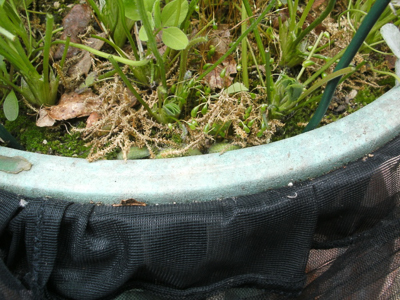 |
| Figure 9. Several pre-pupae clustered next to one another in the warmest part of a tub |
A pupa was placed within a short distance of my Black ant (sensu stricto) workers. The ants showed a great deal of interest but, unaccustomed to the writings of the experts, didn't proceed to bury it, even after the pupa was left in their sole custody overnight.
A fully grown caterpillar, one of the last still feeding, was taken to Firbeck Pit-yard, Nottinghamshire (SK582858) on 22nd May and subjected to workers from one particular nest of Red ant, Myrmica rubra. It was constantly harassed and bitten and, unlike all other species of ant so far tested on Mazarine Blue, this larva reacted visibly each time to this ill-treatment. It failed to erect its tentacle organs but did extrude a droplet of 'honey-dew' from its honey gland, something I'd not witnessed before, and the ants, although touching this spot briefly several times with their jaws, chose not to imbibe. This experiment was repeated close to a second nest of Myrmica rubra ants with very similar results, so the larva was quickly removed and secured out of harm's way. Proceeding lunch, about 30 minutes later, the larva, still with the extruded droplet, was positioned close to a nest of Black ant (sens lat) and, after about five minutes, was found and 'milked', but again failed to erect its tentacle organs. Whether this caterpillar survives is a moot point.
The above-mentioned pupa was placed within easy reach of the first nest of Myrmica rubra, who were as attentive in their attacks as the Black ants in the delicacy of their licking and fondling. It was later realised that rubra is the 'true villain of the peace', accounting for some of the curious behaviour of Mazarine Blue larvae that can partially, if not specifically, be attributed to defensive strategies that have evolved against this particular species of ant (White, 2018).
The last six feeding and fully grown larvae were individually confined on cut flowers of White Clover (Trifolium repens), Zigzag Clover (T. medium) and Meadow Vetchling (Lathyrus pratensis) during the late afternoon of 22nd May and the following night. The Zigzag and vetchling caterpillars (two apiece) fed voraciously, while one of those on White Clover didn't feed at all and was discovered in the morning fixing itself for pupation, while the other, also possibly close to pupation, fed but moderately. Due to the late stage of the larvae, the experiment on White Clover is inconclusive and will need repeating.
Of the 61 caterpillars and pupae of 21st May, one larva presumably escaped through folds in the netting pleats via a tub rim, leaving 60 individuals, of which the last one pupated on the 31st. All but six pupated in the leaf litter or very low down on clover plants. Of the six, one was in the soil next to a cage support wire with the other five on the netting below the rims of various tubs between their two tying points. The larva bitten several times by rubra workers produced a healthy pupa. However, three pupae found together had piercing bite marks similar to those found on the caterpillar discovered dead on the 21st of May. These marks seem to have been made concurrently, when the pupae were all recently formed, possibly by either a spider or flower bug. Interestingly, two of these three pupae were bitten over the former positions of their honey glands. No noticeable degradation, from start to finish, existed in the sizes of the pupae, indicating the stock is healthy and should theoretically produce equal numbers of both sexes.
The first emergence occurred on 31st May, a male, from the first larva to pupate on the 13th, making it 18 days in the pupal stage - a somewhat lengthier duration than Stradomsky's Caucasus individuals of 8 days (Stradomsky, 2012).
The first wild-emerged Mazarine Blue was found two days later than its captive counterpart, also a male, on Meadow 4 at Poulter Country Park (SK52617132), alongside 25 male and 8 female Common Blues (Fig. 10). The butterfly was equal in size to an average example of one of the male Common Blues and noticeably larger than a French Mazarine Blue male of last year (retained as a specimen). On June 2nd, the first females emerged. The three pupae with bite marks all produced healthy adults. On June 3rd, the first pairing was noted late afternoon, lasting 35 minutes.
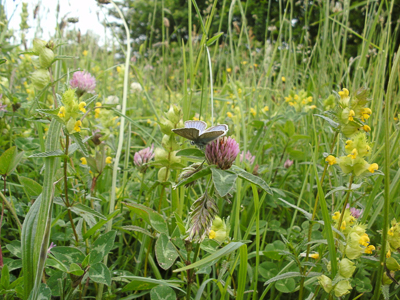 |
| Figure 10. First wild-emerged Mazarine Blue, reported from Meadow 4, Poulter Country Park (SK52617132), Derbyshire, 2nd June 2017 |
Nine males and four females were released on Meadow 5 (SK52627125) on the 4th June. This was half the current emergence, with exactly the same number of butterflies and numbers of each sex retained for breeding. Preference was also given to more recently emerged insects to ensure synchronicity, with a wild emergence behind the captive stock by a single day. At least one of the four released females may already have paired.
On 6th June, the captive emergence reached Median Density with 30 of the 60 pupae having produced 20 males and 10 females. Theoretically, the balance to emerge should be 10 males and 20 females. No eggs had yet been found or any butterfly seen attempting to lay. Dull, wet weather over the previous two days may have accounted for this.
At first it seemed rather coincidental that the exact area selected for the introduction on Poulter Country Park in 2016 should prove to be where a small percentage of Red Clover was found to be flowering on 10th May 2017, ahead of all other nearby locations both inside and outside the park. The area was chosen largely because it has the highest density of ants, so it now seems feasible it also receives the greatest springtime warmth. This would account for the highly unusual, but handy, close synchronicity between the timing of emergence of the first captive-bred butterflies and their feral counterparts - in virtually all cases, captive-bred butterflies will normally emerge much earlier. The species may well spread to other parts of the park and, if so, it will be interesting to see whether it will be in temporal synchronicity with the flowering of the clover as well as the density of ants. Note: ant ecology itself is also known to ameliorate ground temperatures (White, 2016).
One other point of theoretical interest has also come into sharper focus - that of the huge population of earwigs on site (that are strongly associated with Yellow Rattle, Rhinanthus minor) and the defensive capabilities of Mazarine Blue caterpillars to combat them. Earwigs live quite happily alongside all common British grassland species of ant, apart from Wood ants - indeed, they are readily to be found in Wood ant nests, kept almost as pets, unlike slugs whose unfortunate eggs are seemingly predated by both Wood ants and earwigs. Perhaps this abundance of earwigs is the reason Poulter has such a low density of small grey slugs. This circumstance no doubt adds greatly to the species' defence against such a serious foe, but an abundance of earwigs, and with it an increased risk of predation on the butterfly's larvae, most likely does not. Presumably, before hibernation, with neither the glands to attract ants nor the necessity to be guarded by them, the early larvae are given refuge from earwigs by the florets. The exposed development of post-hibernation larvae, on the other hand, coincides with that of the baby earwigs, which in all probability are a lesser threat. Later experiments proved Ladybird larvae only become a threat to late pre-winter caterpillars of Mazarine Blue after they leave the sanctuary of the clover florets (White, 2018). Though, a possible glitch subsequently came to light regarding this theory after reading Frohawk's 1907 breeding account (Frohawk, 1924). This account confirms that larvae have functioning honey glands from the second instar onwards, though not the tentacle organs until after hibernation. Frohawk also incorrectly cites the species as having six instars and not the universally accepted five. My research suggests that the larvae do not possess any glands capable of interacting with ants until the fourth instar - before this stage they are either rudimentary or non-functioning. Common Blue is probably also using similar strategic and advantageous phenomena, as reflected in its generous distribution over the introduction area although, as previously stated, this grassland insect is the one species of butterfly known to live in high numbers in the total absence of ants.
At midday on 7th June, the first captive egg of the season was seen to be laid, the female having hardly moved post-copulation five minutes earlier. This is extraordinary behaviour never seen before by this researcher in any butterfly species. Cut flowering stems of Zigzag Clover in jars of water placed into one of the cages, which provided both a nectar source for the adults as well as a laying medium.
Pairings typically last between thirty minutes and an hour, and can occur anytime during daylight hours when the temperature is above 17 degrees C. One tatty male, likely the first to emerge on 31st May, having already just paired, copulated with a different female about 15 minutes later - two virgin females having been placed in the same cage earlier in the day and four mated ones removed. The male did try to copulate again with the original female soon after his first encounter, but was distinctly rebuffed. The second successful pairing then lasted all night and well past midday of the following day. Females that had just parted from males were, on a few occasions, witnessed to go into an immediate, but brief, egg-laying mode, although only on 7th June did this result in an actual egg being laid. Males rather than females seem to control the duration of time spent in-cop.
The four already-mated females, mentioned above, were transferred to a cage with flowering Broad Bean plants. These nectared sparingly on the terminal flowers, placing just four eggs on nearby buds over the following four days.
On 14th June, eight widely aged, mated females were released on Meadows 4, 5 and 6. A female, thought to be one of these, was intermittently observed laying two hours later, at a rate of one egg per minute over a period of about 20 minutes. The balance of retained females, including six female pupae yet to produce butterflies, now stood at 20 individuals.
Of the final six female pupae, five emerged before 8 am on the 15th. With just one female pupa remaining, it is possible to calculate the Median Density of the captive-bred males on 3rd June and that of the females on 9th (Fig. 11). This equates to an Average Wild Male Longevity of 12 days - using the equation '(Male MD - Female MD) x2'.
Note: this equation only works from healthy British butterfly stocks producing males and females in more or less equal numbers and not in species where there is a delay in female development before mating, such as Brown Hairstreak (Thecla betulae), or in those which hibernate before they, too, become sexually mature. So far, these only ever return a zero result, indicating the sexes emerge randomly. It is assumed the variation in the timing of the sexes is itself a balancing mechanism, possibly controlled by temperature acting on hormones, ensuring there is always an equal selection from which any individual can choose a mate no matter whenever - early, middle or late - in the overall emergence they might occur. In theory, natural selection disadvantages the succession of any creature limited by a lesser choice in the genetic range of its offspring and the time of each sex is a relatively simple biological expression in harmony with the length of the emergence and adult longevity.
Given a Male Longevity of 12 days, together with an approximation of Average Wild Female Longevity at 13 days and a wild emergence say one day behind the captive stock, a Maximum Wild Field Density is expected to have occurred around the 13th of June. Average Wild Female Longevity is based on the empiricism that all Temperate Zone captive-bred, intra-seasonal female butterflies tend to live slightly longer than their equivalent males and this is thought equally likely in the wild.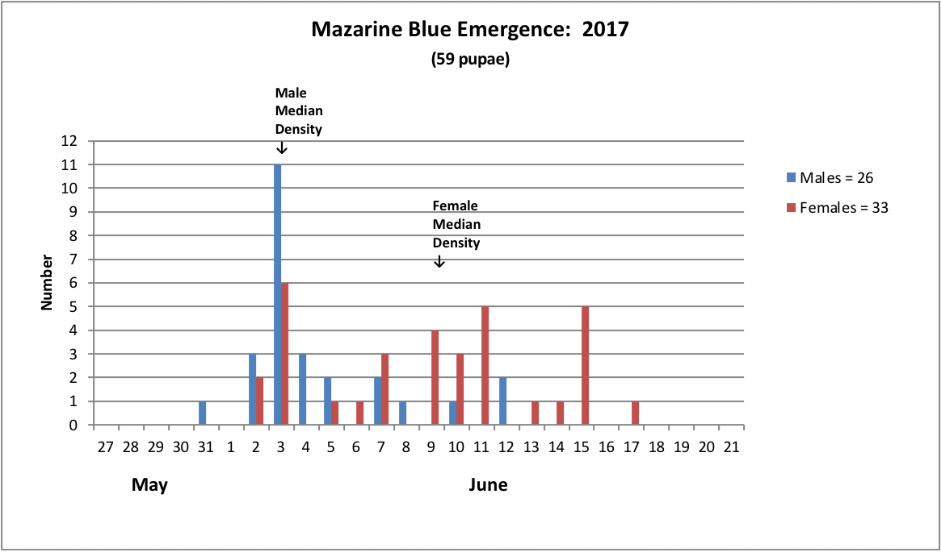 |
| Figure 11. Captive emergence of Mazarine Blues in 2017 |
The present British Mazarine Blue butterfly season should easily be in excess of a month in advance of Samuel Hudson's peak mid-July observation date of 18th July during the early 1860's at Epworth, north Lincolnshire, thirty kilometres to the north of Poulter and less than single day's deviation at a typical rate of springtime progression (Hudson, 1864). Assuming a wild population is successfully established, it is thought likely the median densities of males and females will be seen to alter by one or two days in F1 bred samples produced from captured parents over the course of a few generations, as the longevity of the stock imprints onto its new environment. Also, a Maximum Wild Observation Density is estimated to have occurred around the 11th of June, given the later-occurring females are in all likelihood less obvious than the males.
The aforementioned five virgin females were caged with willing males onto three separate tubs around 10 am. Note: newly emerged butterflies should be 'exercised' for a few hours to rid them of their waste, meconium, before being placed in fresh cages, thereby preventing the communication of disease (Ford, 1973). All were found in-cop by 1 pm. Older males, more than a week after emergence, make for the most eager partners and for successful fertilization. Again, the oldest male, at 16 days old, made straight for his female of choice and has quite possibly mated with better than half a dozen of the females, both released and retained.
12 old males, now surplus to captive-requirement, were released on Meadows 4, 5 and 6 on the 16th. An encounter at Poulter between a male Common Blue and a wild-emerged male Mazarine Blue on the 15th resulted in the briefest curiosity from the Common Blue, which then chased away a rival male of his own species in aerial acrobatics.
Several caged females were given a free choice of various laying and nectaring media. They commonly frequented Meadow Vetchling as a food source, but in total only laid a single egg on a floret of this species, much preferring instead to deposit copious quantities on young flowers of Zigzag Clover, with a lesser number also being placed on the now nectar-depleted flowers of Red Clover. This experiment was repeated the following day in a further cage with exactly the same result.
On 17th June, a captive female was found dead. The last butterfly emerged from its pupa around midday on the same date, formed from the last larva to pupate on 31st May. Interestingly, at 18 days in the pupal stage, this is the same duration as that of the first butterfly to emerge. One worn, old female found in-cop, possibly previously unmated, might explain a number of earlier collapsed eggs, although it seems likely that females may mate more than once if the first or subsequent unions begin to fail in terms of available nutrients passed from the male, or there is a failure to fertilise eggs. Conversely, multiple parings by females may be a mechanism to ensure greater diversity of progeny.
The flowering of Red Clover at Poulter was at its very best on 18th June, which coincided to an estimated median hatching of wild larvae two or three days later. All remaining captive butterflies, 4 males and 19 females, were liberated on Meadows 4 and 5. The final female failed to pair and was likely the only one of these particular females to be freed without having already found a mate. Before all were boxed for transport, a second female was found dead. It now seems likely that both this death and the first can be attributed to predation by ladybird larvae introduced into the cages to control aphids.
Of the 60 pupae, one was missing due to a miscount, making a total emergence of 26 males and 33 females. Of these, one male escaped in Worksop, two females were predated, and 25 males and 31 females were liberated (c.27 females mated beforehand). All released butterflies were in no way seen to be 'cage-happy' and immediately set about typical wild behaviour. This is certainly not usual of most captive-caged stocks, which typically take a day or two to adjust to their new environment.
The fertile captive egg count totalled 1,700. A further 500 eggs proved infertile or collapsed. A nine-day-old female lays a mean of 38 fertile eggs per day during hot sunny weather. Usually, captive females lay increasing amounts as they age, with younger individuals probably accounting for more infertile ova. These last two facts are most probably not repeated in the wild as the captive diet was supplemented with diluted mead, which certainly makes for more obliging butterflies.
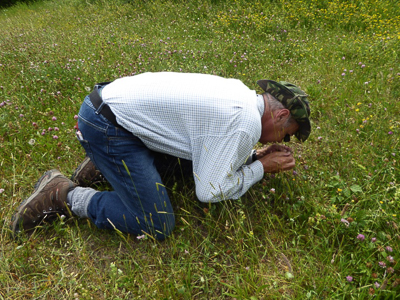 |
| Figure 12. The author looking for wild-deposited eggs |
The first caterpillar was found hatched on 18th June from an egg laid on the 10th.
No wild-emerged females had been positively witnessed up to the 18th, although the males, mint specimens and not liberated cage-clipped examples, provided sightings of one or two butterflies per day with a maximum tally of five on 10th June. A total year-population for Poulter is probably slightly fewer than a hundred adults. However, 2017 wild egg numbers should easily have reached 5,000, compared to probably only 250 in 2016. A maximum female fecundity is somewhere around 500 progeny.
During the hotter days up to 21st June, eggs are beginning to hatch after just six days since laying, instead of the usual eight days. The first definite wild-emerged female was seen on the 21st on Meadow 6 (SK52747119), together with 15 male and 4 female Common Blue. Approximately 20 larvae and a few eggs, lost in stemmings, were liberated on Meadow 5 amongst herbage dominated by Red Clover.
The last reliable 2017 Mazarine Blue record for Poulter was made on 1st July and consisted of two males and one female seen on Meadow 5. These probably represented a mixture of wild-emerged and captive-released butterflies.
People were still arriving at Poulter as late as early August in the hope of seeing the species. The butterflies were no doubt long finished with the vast majority of wild caterpillars already well asleep for the winter, as indeed were all those retained.
My grateful thanks go to the following individuals for their kind help: Phil Attewell (archives); James Dickinson (records); Mike Fox (ant determination); Colin Hart and John Langmaid (A.E.S., technical advice and moth determination); Kieren Pitts (A.E.S.); Richard Priestley (records and breeding); Roy Frost (records); Pete Smith (breeding and technical advice); Iaian Stafford (habitat management); Peter Summers (records and archives); and lastly Heidi (canine services).
Martin's work on the Mazarine Blue project continued beyond 2017, with the same enthusiasm and passion, until his passing in 2020. This postscript is intended to provide a few highlights of 'what happened next?', and the Dispar editorial team would like to thank Pete Smith for providing the details below. We hope that this brief summary inspires those that are looking to build upon Martin's work which has, undoubtedly, improved our understanding of the ecology of the Mazarine Blue and the potential for it to be reintroduced to its former home in Britain.
After the initial breeding project, up to the end of 2017, Martin spent some time researching alternative foodplants for his captive breeding of the Mazarine Blue, partly due to problems with aphids on Red Clover alluded to in this article. Martin went to some effort to obtain foodplants that were potentially used on the continent, including Prostrate Canary Clover (Lotus dorycnium) obtained from a French nursery, which was not a success. Martin also trialled Hairy Canary Clover (Lotus hirsutus) and had great success - the hairs on this plant repelled aphids and resulted in much better larval survival rates. Female Mazarine Blues were also happy to use this plant when both nectaring and egg laying, and this plant became the foodplant of choice for captive rearing.
On 7th August 2018, Martin liberated a small number (<20) pre-hibernation larvae into a new site in Lincolnshire. At least one male Mazarine Blue was seen in June 2019, indicating successful overwintering at this site, opening up a new avenue of potential research.
The warm weather during 2018 resulted in some of the captive-reared larvae failing to enter diapause, and an unwanted partial second brood emerged. On 30th August 2018, a small number of second brood males and females were released at another Lincolnshire site that held appropriate axiophytes and masses of Red Clover, and was also home to Small Heath, Common Blue and Marbled White, suggesting the presence of suitable ant species. Unfortunately, the site was grazed quite heavily over the winter months, and it is thought that this release failed.
Martin had been diagnosed with terminal cancer of the throat and oesophagus and knew that he was unlikely to see Christmas of 2020. Martin decided to release the remaining Mazarine Blue stock in the summer of 2020 at one of his previous sites in Lincolnshire, a site where there were large patches of Zigzag Clover, and further smaller areas of Red Clover. Dingy Skipper was present, and a single Small Heath was also observed at the site. Like any good scientist, Martin was brutally honest - he thought this release would ultimately fail, given what he now knew about the Mazarine Blue and its requirements, but felt that considerable progress had been made nonetheless.
On 13th October 2020, a day after Martin died, the Guardian published an article by Patrick Barkham that featured Martin and his work. Patrick's Guardian article and Martin's article here are a fitting swan song to a genius butterfly breeder and unique individual.